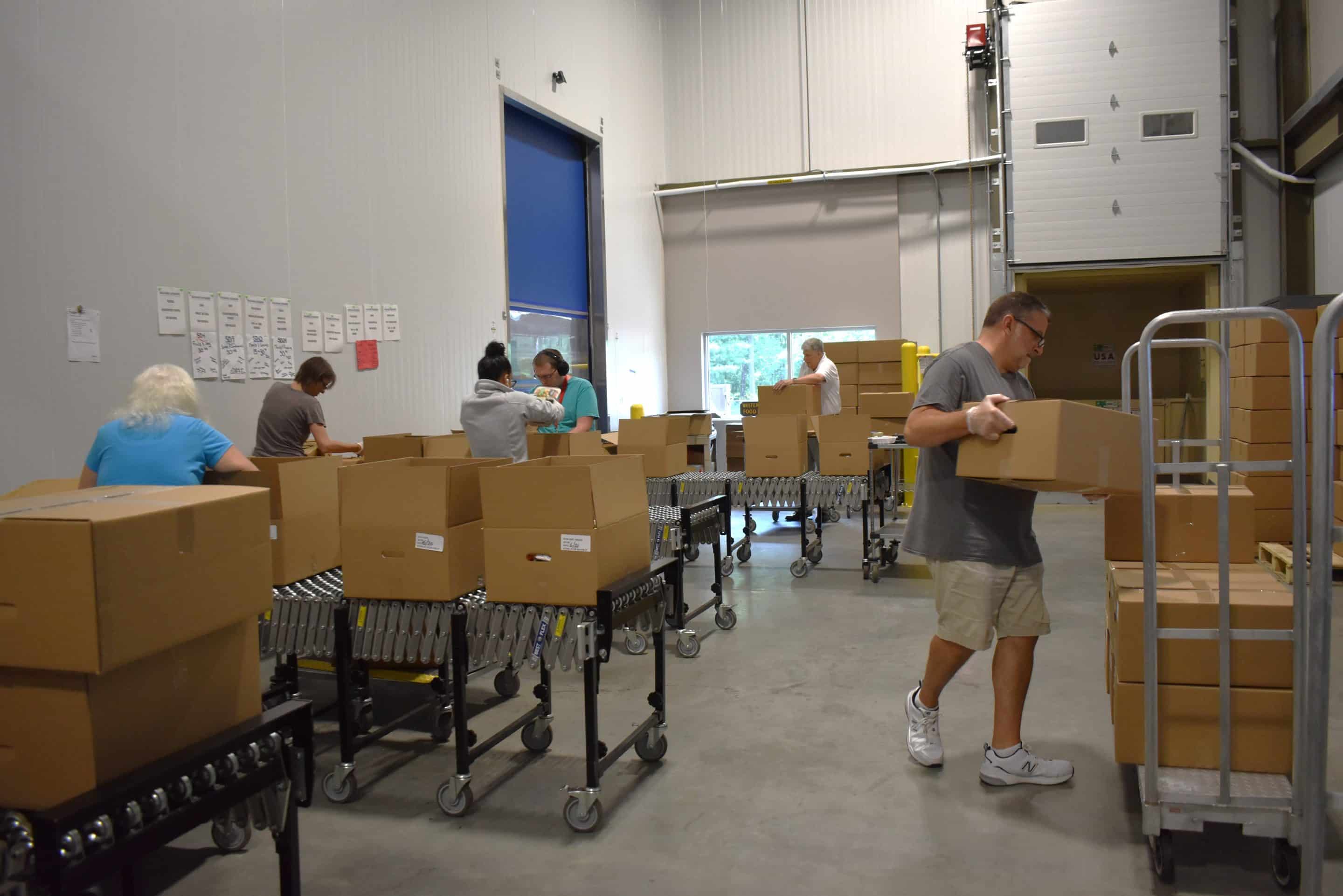Volunteers sort and box meats for food pantries.
Reminder Publishing photo by Amy Porter
CHICOPEE — With the increased capacity of its new location on 25 Carew St. in Chicopee, the Food Bank of Western Massachusetts is better able to confront the 44% increase in food insecurity brought on by inflation and the end of coronavirus pandemic-era funds, according to Executive Director Andrew Morehouse.
“We have room to grow,” Morehouse said on a recent tour of the facility. “The warehouse is 32,000 square feet — it was 16,000 square feet in Hatfield; it’s twice the size and three times the capacity due to fourth row racking. There are nine truck bays, three times the bays in the other building.”
Morehouse said the new highly efficient building was built “to meet our needs,” after a campaign launched in January 2021 that raised $30 million in public, corporate and individual donations, at about a 50/50 public-private split, he said. The new location opened in September 2023.
The Food Bank of Western Massachusetts, established in 1982, serves 188 food pantries and sites in Berkshire, Franklin, Hampshire and Hampden counties for food distribution. The food comes from the Massachusetts Emergency Food Assistance Program, or MEFAP, the federal Emergency Food Assistance Program, TEFAP, retail and wholesale food businesses; local farms and two food bank farms located in Hadley; community organizations and private individuals.
Morehouse said a third of the food that is purchased by the food bank from suppliers and farms is purchased with state MEFAP funds.
In 2023, the food bank served the equivalent of 10.8 million meals through its network — 107,000 individuals in a month; a 29% increase from a low point of 83,000 the year before.
“In the first few months since moving in, we provided 29% more food than the same period last year. Greater capacity permits receiving so much more donated food. We will be able to provide the equivalent of more than three meals for every dollar donated,” Morehouse said.
The Chicopee location is also closer to a lot more food businesses and warehouses, allowing for a lot more donations of food. He said donations increased by 34% in the first nine months from September 2023 to May of this year, something Morehouse said the organization had hoped for in making the move.
Chicopee is also closer to the population centers of Hampden County. Morehouse said the food bank is able to serve more towns and have a greater reach into Chicopee, Springfield and Holyoke, the largest populations living with food insecurity. Morehouse said he has hired a dedicated staff person to recruit more pantry and meal sites in all four counties, and especially in the Springfield area.
For cities and towns that are now farther away — such as Pittsfield, where a tractor-trailer transports 24,000 pounds to the Berkshire Community Action Center every Tuesday in a partnership with Big Y — the food bank is ramping up delivery. He said the weakest link is finding truck drivers.
“That is why partnership is so important to us. GoodWill goes to the Pittsfield drop and delivers to North Adams and Adams,” Morehouse said. He added that it’s also harder for small partners in Franklin County to come and get food. He said they are planning to expand delivery for pantries and meal sites, and provide more culturally responsive food.
Food is also brought directly to households facing food insecurity at 26 mobile food bank locations set up monthly in parking lots of community partners. The food from the mobile food bank trucks go directly to individuals, with no eligibility requirements. He said volunteers help put the food out at the mobile food bank locations.
Morehouse said overall, food at the food bank is now more available, more culturally responsive and subsidized. Eighty-five percent of the food from the food bank is free to food pantries. There is a shared maintenance cost of 10 to 19 cents per pound for donated meat and dry goods, which was waived during COVID-19. He said they do not charge for the $1 million of food purchased by the food bank.
Besides food distribution, the mission of the food bank, its staff of 75 and a thousand plus volunteers includes public education and advocacy around the underlying causes of food insecurity and hunger.
Last year, food bank staff assisted 568 households to enroll in the federal Supplemental Nutrition Assistance Program, or SNAP, formerly known as the food stamp program, providing the equivalent of one million meals over 12 months.
Morehouse said the SNAP program provides nine meals for every one provided by all 200 food banks across the country. Seventeen percent of the state population — one in six — receives SNAP benefits; including 224,000 individuals in the four counties of Western Mass.
Nutrition education is another area of focus for the food bank. A large Community Room and kitchen in the new building has allowed the food bank to host nutrition education workshops in house. Morehouse said recently they hosted a family recipe campaign with the schools. He said families came and paired up with their child to prepare a favorite family recipe. The winner, which happened to be meat loaf, will be added to the school lunch menu.
Morehouse said the food bank has food assistance navigators on staff to work with medical professionals for patients who screen positive for food insecurity in hospitals and medical settings, something they have been doing for a few years. They also have staff working with 52 councils on aging to provide brown bag meals for seniors.
All four food banks in the state along with Project Bread have joined together in a new statewide coalition, to “Make Hunger History in Massachusetts,” (makehungerhistoryMA.org.) The goal is a state where “no family goes hungry, where every child has access to nourishing food, and where hunger is a thing of the past” through policy change, community engagement and collective action.
“Hunger is still increasing. We need to continue to work to dig deeper, more holistically to turn this trend around. We can’t feed our way out of this,” Morehouse said.
He noted that volunteers are always needed. The food bank has corporate groups and church groups that work once a month or once a quarter; as well as retirees and groups with disabilities.
There are also volunteers who come weekly and work a regular shift. On the Thursday of the tour, volunteers were in the sorting room, inspecting meat packages donated by Big Y and sorting them with like-meats into 30 pound boxes to be stored in inventory.
Morehouse said right at the sell-by dates supermarkets freeze the meats instead of throwing them out. Pantries and meal sites can then order the boxes of meat online at 19 cents a pound, or less than $6 a box.
Asked what people can do to support the mission of the food bank, Morehouse said three words, “Volunteer, advocate and donate,” and suggested people visit the website at foodbankwma.org.



